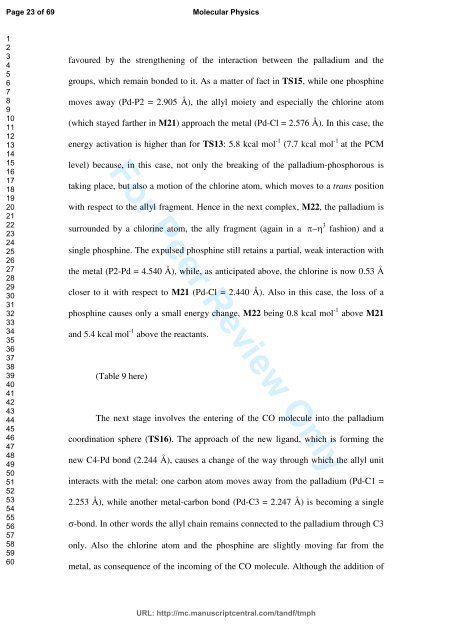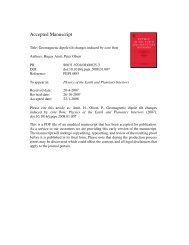For Peer Review Only - TARA
For Peer Review Only - TARA
For Peer Review Only - TARA
You also want an ePaper? Increase the reach of your titles
YUMPU automatically turns print PDFs into web optimized ePapers that Google loves.
Page 23 of 69<br />
Molecular Physics<br />
1<br />
2<br />
3<br />
4<br />
5<br />
6<br />
7<br />
8<br />
9<br />
10<br />
11<br />
12<br />
13<br />
14<br />
15<br />
16<br />
17<br />
18<br />
19<br />
20<br />
21<br />
22<br />
23<br />
24<br />
25<br />
26<br />
27<br />
28<br />
29<br />
30<br />
31<br />
32<br />
33<br />
34<br />
35<br />
36<br />
37<br />
38<br />
39<br />
40<br />
41<br />
42<br />
43<br />
44<br />
45<br />
46<br />
47<br />
48<br />
49<br />
50<br />
51<br />
52<br />
53<br />
54<br />
55<br />
56<br />
57<br />
58<br />
59<br />
60<br />
favoured by the strengthening of the interaction between the palladium and the<br />
groups, which remain bonded to it. As a matter of fact in TS15, while one phosphine<br />
moves away (Pd-P2 = 2.905 Å), the allyl moiety and especially the chlorine atom<br />
(which stayed farther in M21) approach the metal (Pd-Cl = 2.576 Å). In this case, the<br />
energy activation is higher than for TS13: 5.8 kcal mol -1 (7.7 kcal mol -1 at the PCM<br />
<strong>For</strong> <strong>Peer</strong> <strong>Review</strong> <strong>Only</strong><br />
level) because, in this case, not only the breaking of the palladium-phosphorous is<br />
taking place, but also a motion of the chlorine atom, which moves to a trans position<br />
with respect to the allyl fragment. Hence in the next complex, M22, the palladium is<br />
surrounded by a chlorine atom, the ally fragment (again in a π−η 3 fashion) and a<br />
single phosphine. The expulsed phosphine still retains a partial, weak interaction with<br />
the metal (P2-Pd = 4.540 Å), while, as anticipated above, the chlorine is now 0.53 Å<br />
closer to it with respect to M21 (Pd-Cl = 2.440 Å). Also in this case, the loss of a<br />
phosphine causes only a small energy change, M22 being 0.8 kcal mol -1 above M21<br />
and 5.4 kcal mol -1 above the reactants.<br />
(Table 9 here)<br />
The next stage involves the entering of the CO molecule into the palladium<br />
coordination sphere (TS16). The approach of the new ligand, which is forming the<br />
new C4-Pd bond (2.244 Å), causes a change of the way through which the allyl unit<br />
interacts with the metal: one carbon atom moves away from the palladium (Pd-C1 =<br />
2.253 Å), while another metal-carbon bond (Pd-C3 = 2.247 Å) is becoming a single<br />
σ-bond. In other words the allyl chain remains connected to the palladium through C3<br />
only. Also the chlorine atom and the phosphine are slightly moving far from the<br />
metal, as consequence of the incoming of the CO molecule. Although the addition of<br />
URL: http://mc.manuscriptcentral.com/tandf/tmph
















